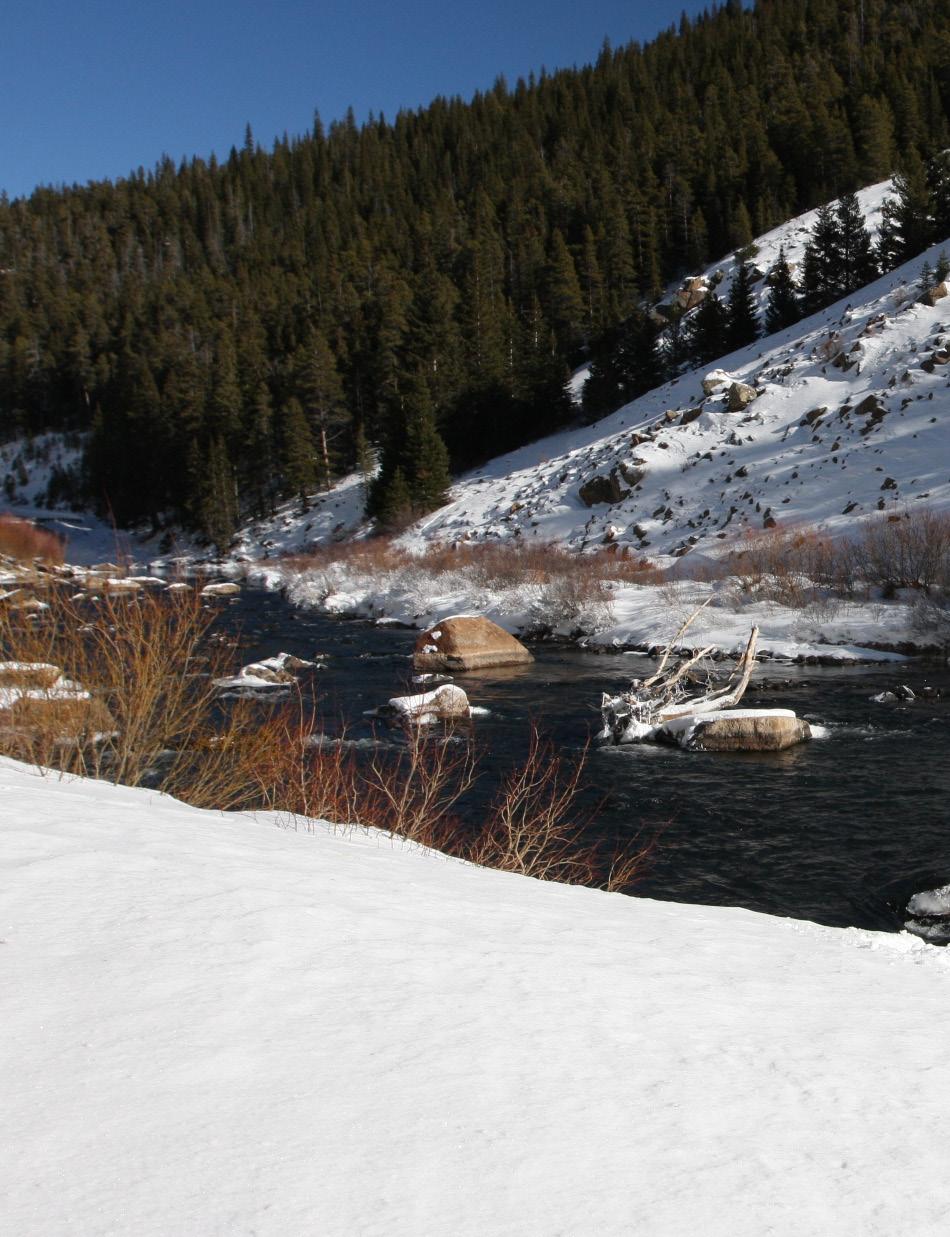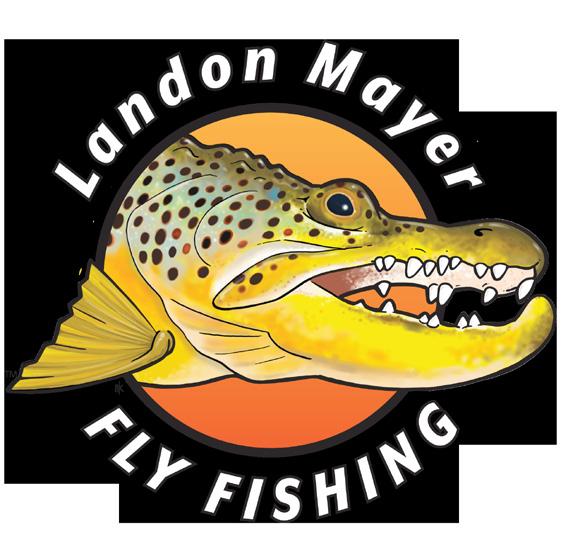
9 minute read
THE SPRING SCHEDULE

Spring is often a welcome sight for anglers looking forward to the productive warming water ahead, sun filled skies, and most importantly, the opportunities at both resident and migratory trout. Typically, fish begin to migrate, looking for a suitable water to spawn, take advantage of new food supplies, and explore new locations to call home for the summer. With all this movement in mind, one of the best ways to be successful during the spring is by timing your hunts. The following are opportunities and ways to locate more and larger trout: Opposites Attract
Over the years I have learned that timing the movement of trout is not always based on the spawn; sometimes, I have found that it is the opposite season’s species that need to be targeted.
I was first exposed to this while guiding in Alaska, and found that the importance of when the salmon would move in would determine how we targeted the trout moving behind. With such a healthy supply of eggs and natural insects, the rainbow simply could not resist following the salmon as they move. The same can happen in the spring. Unlike the fall months, in the spring when Rainbows and Cutts are spawning, it is not uncommon to have browns and brook trout following in pursuit. With the chance that there are eggs that will dry up, insects kicked up off the bottom, and natural hatches, there is incentive for the opposite species to be attracted to the spring opportunities for food. If targeting this timeframe, you want to make sure that you’re fishing at the peak of when the opposite fish move, but most importantly that you’re targeting deep water in areas were trout are not spawning. This will help you avoid the naturally reproducing trout while pursuing browns, or other species that are eager for a meal.
Some of my favorite zones are deep pockets, drop lines, or the tailouts of a run. It can also be productive to fish the edge of the river on the side of deep runs, or a fast lane that water rips through--delivering drifting food supplies like eggs. In rigging for these situations with the opposite species, eggs can be a good choice, as can scuds in gray and orange, and matching natural food like blue-winged olives and midges. That way you’re getting more bang for your buck with an egg trailing behind a natural. Don’t forget about the opportunity to throw streamers with these fish that are eagerly searching the easy meal. Timing Tips
Timing is crucial in fly fishing, and this is especially true when hunting trout at the top of the food chain. Yes, that can sound cliche, but after spending my whole adult life on this emotional fly fishing roller coaster, and countless hours flying, driving, hiking, rowing, climbing, and crawling, I can personally tell you that if your timing is off, you are wasting your time. The reason behind this is that large trout have a well-defined schedule, and whether it is migration to spawn, moving for food, or adapting to pressure, they live by this code.
Think of timing migration in windows that can be tracked and refined over the years, to the point that you know what the window will be, within two or three weeks. Light and water temperature come together with the right timing of the perfect window.
“To move from one region or habitat to another, especially regularly according to the seasons.” This is the definition of “migrate,” and it is a sentence that should be etched into every large trout hunter’s mind. You build confidence and gain success my learning the migrational patterns of large trout that you pursue. Catching large trout is not easy, and that is part of what makes it fun. The reward of the catch, adventures spent on the water with friends, and learning from new days and conditions is what makes you a better angler.
One of my favorite times during any day is not even while on the water fishing… it is in the evening, or hours resting off the water, when I am filtering through all the knowledge gained during that day. This forces you to think about different ways to fish and ultimately leads you to success through trial and error. The first stage in matching the migration is to figure out if the trout you are pursuing are resident or migratory.

Resident Behavior
Trout do migrate within the river or still water where they live; however, they normally do not cross the boundary or line from still water to moving water. Anglers have access to these trophies throughout the year at any given time, because they stay in the same neighborhood. I have found resident fish to be more selective than migratory trout, because nothing they see is new. They tend to stick to the same food, holding water, and time of day or year. This means they have literally seen it all. When timing the hunt for these fish, it’s helpful to remember that they feel most protected from “predators” above them in low light or dark water. Stormy weather, sunrise, sunset, and runoff are just a few good examples.
It is important to figure out whether the trout you are pursuing are migratory or resident. Resident trout are familiar with the water, and their body color and markings are designed to prevent any predator from above being able to see them. In some waterways, the fish can almost appear black on the back, because they are matching the dark river or still water bottom. From a side angle view, this can stick out like a sore thumb, but to an eagle above, it is hard to see the fish. The other way resident fish keep from being seen is that they tend to hold still more than a migratory trout, which helps to prevent them from being snatched by predators. In addition, they are used to waiting for the food to come to them. This can make finding these trout harder, because they are mainly not on the move.
When deciding when to fish for large resident trout, I rely on the fish’s food supply to get them out of hiding. This is when a heavy hatch, hopper blown off the bank, drowned mouse, or dead drifting baitfish can produce a fish of a lifetime.

Lastly, I believe resident trout are used to having the lights on, with everything brighter compared to a deep body of water that a migratory trout will be living in. This means that you don't have to always rely on low light to target fish. As long as the fish is attracted to a big meal or never-ending snack, they can be found. Migratory Behaviors
Trout are a different animal (so to speak)! Coming from deep, dark places like oceans, large lakes, and deep reservoirs, they are new to the river or the edge of the still water, and they do not leave the lights on! In fact, a majority of the trout that I or my clients have landed are not in bright conditions. They are caught using the dark water delivery mindset—whether it is dark stormy skies, dirty water, sunrise and sunset, or, of course, the night bite.
Fish on the move hold in the most bizarre locations! This used to throw me for a loop until I started looking at the river like a highway that the fish travel on, stopping in deep runs or around structure, and moving to the water in-between—making the whole river available for them to stop and hold. Unlike resident trout, they do not know that the 12 inches of riffled water along the river’s edge is leaving them exposed. I think the trout simply stop because they cannot see past the distorted surface, and it feels safe. We have all been there when we sit in a movie theater watching the screen in a dark room, and after a few hours, step outside and are blinded by the bright summer rays. That is what I believe migratory trout feel like, and that is the reason dark water delivers.
To start, I break the river down into three zones: Staging runs that are found in locations like bailouts on the river, and inlets to a still water that can hold fish in the moving or still water.
Feeding zones like riffles above the deep tailout, structure above the inlet, eddies, and undercut where the fish can hold to consume the next meal before they run.
2nd Edition! Order Your Copy Today!




NEW VIDEO! Order Your Copy Today!

Finally, migrating water between deep runs or edges, where the fish can swim next to a bank, or around islands where they feel safe when they swim. While you can see the targets moving, sometimes with a back out of the water, I have learned that a fish on the move in many situations is not a feeding target. I prefer to set my sights on the fish which are holding, or staged, next to cover, where they feel safe. The next time you are waiting out a late winter storm with a bout of cabin fever, consider these tips for your upcoming hunts. With spring weather right around the corner, you are sure to up your trophy trout hunting game as soon as fishing season kicks into high gear.
About The Author
Landon Mayer is a veteran Colorado guide and author of several books. His newest books, The Hunt for Giant Trout, and Sight Fishing for Trout (Second Edition) can be purchased on his website, at www.landonmayerflyfishing.com. His newest video, Master the Short Game, by Headwater Media, can be purchased at www.mastertheshortgame.com.
You can follow Landon on Instagram at @landonmayerflyfishing.





www.HCAezine.com Spring 2020 • High Country Angler 15 River Conservation &Fly Fishing Youth Camp COLORADO TROUT UNLIMITED'S WH E N : J u n e 7 - 1 3 , 2 0 2 0 WH E R E : S i l e n t S p ri n g R e s o rt , Al m o n t , C O WH O : Yo u t h 1 4 - 1 8 ye a rs C O S T: R e g i s t ra t i o n fe e - $ 5 0 ( d u e wi t h re g i s t ra t i o n fo rm s ), Tu i t i o n - $ 4 5 0 , S c h o l a rs h i p s a va i l a b l e Today's campers become tomorrow's conservation leaders.







